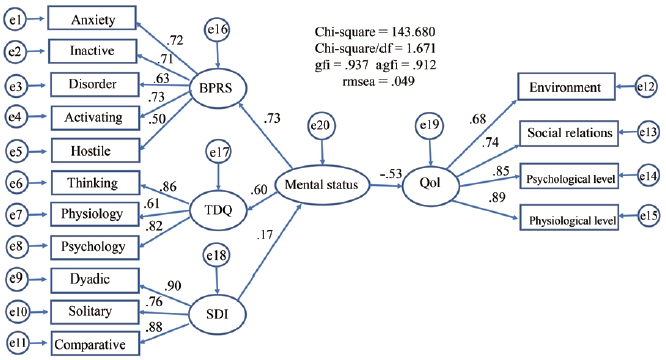 |
 |
- Search
| Psychiatry Investig > Volume 20(1); 2023 > Article |
|
Abstract
Objective
Methods
Results
Notes
Availability of Data and Material
The datasets used during the current study are available from the corresponding author on reasonable request.
Conflicts of Interest
The authors have no potential conflicts of interest to disclose.
Author Contributions
Conceptualization: Mei Hua Chung, Mi Chia Ma, Jian Kang Chao. Data curation: Mei Hua Chung, Mi Chia Ma, Jian Kang Chao. Formal analysis: Mi Chia Ma, Jian Kang Chao. Funding acquisition: Jian Kang Chao. Investigation: Mei Hua Chung, Jian Kang Chao. Methodology: Mei Hua Chung, Mi Chia Ma, Jian Kang Chao. Project administration: Mei Hua Chung, Jian Kang Chao. Resources: Mei Hua Chung, Jian Kang Chao. Software: Mi Chia Ma, Jian Kang Chao. Supervision: Mi Chia Ma, Ru Wei Lin, Jian Kang Chao. Validation: Mi Chia Ma, Ru Wei Lin, Jian Kang Chao. Visualization: Mi Chia Ma, Jian Kang Chao. Writing—original draft: Jian Kang Chao. Writing—review & editing: all authors.
Funding Statement
None
ACKNOWLEDGEMENTS
Figure 1.

Table 1.
| Variable | Female (N=83) | Male (N=194) | p |
|---|---|---|---|
| Age (yr) | 45.49±7.28 | 43.11±8.80 | 0.014* |
| Education level (yr) | 11.07±3.29 | 10.93±2.88 | 0.871 |
| BPRS | 8.35±6.86 | 10.04±6.53 | 0.019* |
| BMI (kg/m2) | 25.65±3.98 | 24.88±3.98 | 0.252 |
| Quality of life | 59.40±15.96 | 60.64±15.43 | 0.461 |
| Depression | 10.04±9.78 | 9.36±10.37 | 0.572 |
| Sexual desire total | 14.31±17.71 | 32.77±25.23 | <0.001* |
| Solitary | 3.94±6.03 | 9.18±8.17 | <0.001* |
| Dyadic | 7.37±9.98 | 16.01±13.76 | <0.001* |
| Comparative | 2.83±3.62 | 7.53±5.70 | <0.001* |
Table 2.
| Variable |
Female |
Male |
p | |||
|---|---|---|---|---|---|---|
| BMI<27 (N=55) | BMI≥27 (N=28) | BMI<27 (N=137) | BMI≥27 (N=57) | |||
| Age (yr) | 45.60±7.30 | 45.29±7.35 | 43.71±8.81 | 41.67±8.68 | 0.133 | |
| Education level (yr) | 11.44±3.08 | 10.36±3.62 | 10.95±2.82 | 10.89±3.05 | 0.197 | |
| BPRS | 8.24±7.28 | 8.57±6.08 | 9.72±6.57 | 10.82±6.41 | 0.072 | |
| Quality of life | 59.31±16.87 | 59.57±14.28 | 61.94±16.31 | 57.53±12.66 | 0.130 | |
| Depression | 9.62±9.38 | 10.86± 9.45 | 8.78±9.34 | 12.19±12.27 | 0.303 | |
| Sexual desire total | 12.49±16.58 | 17.89±19.58 | 31.30±25.71 | 36.30±23.89 | <0.001* | |
| Solitary | 3.47±5.90 | 4.86±6.46 | 8.69±8.13 | 10.35±8.30 | <0.001* | |
| Dyadic | 6.49±9.15 | 9.11±11.43 | 15.15±13.93 | 18.07±13.23 | <0.001* | |
| Comparative | 2.44±3.46 | 3.61±3.86 | 7.42±5.91 | 7.81±5.22 | <0.001* | |
Table 3.
| Variable | <20 yr (N=85) | 20-29 yr (N=145) | ≥30 yr (N=47) | p | |
|---|---|---|---|---|---|
| Age (yr) | 39.62±8.17 | 44.24±7.68 | 50.13±6.82 | <0.001* | |
| Education level (yr) | 10.91±2.80 | 10.89±3.06 | 11.36±3.21 | 0.549 | |
| BPRS | 10.25±6.57 | 9.50±6.85 | 8.36±6.19 | 0.271 | |
| Quality of life | 57.52±15.30 | 60.53±15.29 | 64.45±16.22 | 0.030* | |
| Depression | 11.88±10.13 | 9.39±10.11 | 7.64±9.33 | 0.012* | |
| Sexual desire total | 27.95±25.18 | 28.60±25.67 | 21.74±20.03 | 0.368 | |
| Solitary | 7.65±8.12 | 8.12±8.29 | 5.94±6.61 | 0.418 | |
| Dyadic | 14.00±14.09 | 14.05±13.68 | 10.43±10.33 | 0.473 | |
| Comparative | 6.20±5.83 | 6.34±5.74 | 5.32±4.65 | 0.726 | |
Table 4.
| Variable | <10 yr (N=27) | 10-19 yr (N=90) | 20-29 yr (N=119) | ≥30 yr (N=41) | p | |
|---|---|---|---|---|---|---|
| Education level (yr) | 11.44±2.98 | 10.64±2.87 | 10.97±2.96 | 11.39±3.43 | 0.450 | |
| BPRS | 7.41±6.63 | 10.46±6.43 | 9.55±6.83 | 8.88±6.52 | 0.100 | |
| Quality of life | 60.00±17.29 | 57.99±15.72 | 61.87±14.91 | 58.20±15.48 | 0.249 | |
| Depression | 7.30±8.75 | 11.53±11.518 | 9.32±9.37 | 9.44±9.12 | 0.253 | |
| Sexual desire | 31.00±22.76 | 33.76±25.87 | 22.37±22.82 | 24.59±25.77 | 0.005* | |
| Solitary | 8.00±7.57 | 9.24±8.82 | 6.66±7.30 | 6.51±7.89 | 0.091 | |
| Dyadic | 16.15±12.40 | 16.90±14.13 | 10.52±11.98 | 12.39±14.17 | 0.002* | |
| Comparative | 7.62±6.36 | 7.62±5.96 | 5.66±5.45 | 5.18±5.78 | 0.008* | |
Table 5.
| Coefficient | SE | p | OR | 95% CI | |
|---|---|---|---|---|---|
| Constant | 0.813 | 0.262 | |||
| BPRS | -0.086 | 0.023 | <0.001* | 0.918 | 0.878-0.960 |
| Depression | -0.049 | 0.016 | 0.002* | 0.952 | 0.923-0.982 |
| Sexual desire | 0.013 | 0.006 | 0.018* | 1.013 | 1.002-1.024 |
REFERENCES
-
METRICS

-
- 0 Crossref
- Scopus
- 2,358 View
- 104 Download
-
Associated Factors of Quality of Life in First-Episode Schizophrenia Patients2011 September;8(3)







